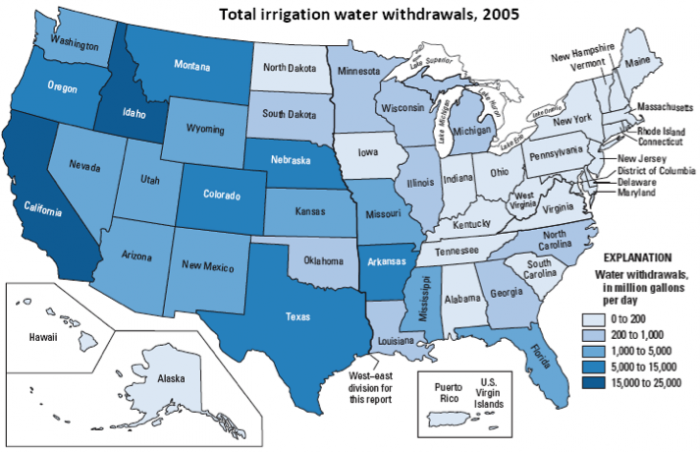Module 4.2: Impacts of Food Production on Water Resources
Introduction
Agricultural food production impacts water resources by depleting quantities of both surface water and groundwater and by polluting surface and groundwater with pesticides and fertilizers. Module 4.2 includes a brief introduction to the impacts of agriculture on water resources, followed by two case studies: the Colorado River (flow depletion and salinity) and the Mississippi River (nutrients, eutrophication, and the hypoxic zone in the Gulf of Mexico).
In completing this module, you will be able to:
- Attribute major water pollutants to appropriate agricultural sources
- Summarize the major impacts of agriculture on water resources
- Relate nutrient loading from fertilizer use to the dead zone in the Gulf of Mexico
Agricultural production has significant impacts on both the quality and quantity of surface and groundwater resources around the globe. In this unit, we'll look at how agricultural activities can contribute to water pollution, and we'll also consider how the diversion of irrigation water from both surface and groundwater resources creates significant impacts on those water resources and the ecosystems they sustain. Some of the critical issues connecting agricultural activities with water resource quality and quantity are:
- Agricultural groundwater removal generally exceeds the natural recharge rate, and groundwater overpumping causes irreversible land settling and loss of aquifer storage capacity.
- Surface water diversion contributes to downstream ecosystem deterioration.
- Agricultural non-point source pollution is an important contributor to water quality degradation.
Impacts of Water Withdrawals
As discussed in the first part of Module 4, in regions where precipitation is insufficient to grow crops, irrigation water is drawn from lakes, rivers, and aquifers to supplement the insufficient or unreliable precipitation. Water diversions for irrigation can have impacts on both surface and groundwater resources.
We saw earlier in this module that the western US receives less precipitation than the eastern US. What does that mean for irrigation needs? The western US withdraws more water from lakes, rivers, and groundwater for irrigation than the eastern US (Figure 4.2.1). These water withdrawals are not without impacts, as we will see throughout the rest of this module. Figure 4.2.1 maps the water withdrawal data we explored in the previous unit. Do you remember the three states in the US that diverted the most water for irrigation in the US? California, Idaho, and Colorado. But Nebraska irrigated more acres than both Idaho and Colorado. In the map in Figure 4.2.1, you can clearly see the states that use the most irrigation water. Next, we'll look at some of the impacts of surface and groundwater withdrawals.

